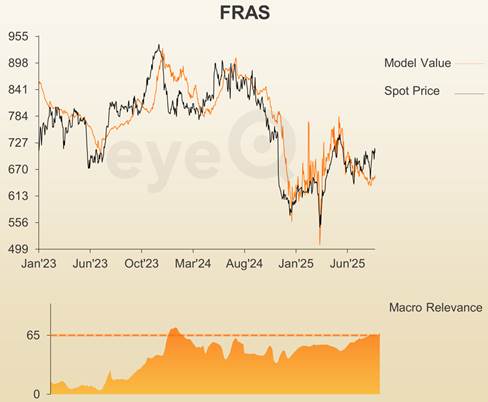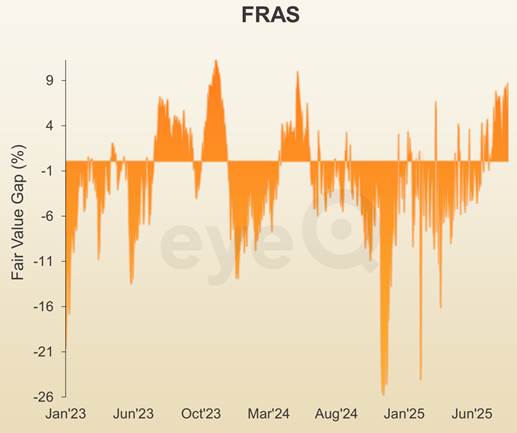eyeQ: what our model says about this FTSE 250 share
Experts at eyeQ have used AI and their own smart machine to analyse macro conditions and generate actionable trading signals. Here it examines a midcap defying the gloom - for now.
17th September 2025 09:01
by Huw Roberts from eyeQ

“Our signals are crafted through macro-valuation, trend analysis, and meticulous back-testing. This combination ensures a comprehensive evaluation of an asset's value, market conditions, and historical performance.” eyeQ
- Discover: eyeQ analysis explained | eyeQ: our smart machine in action | Glossary
Frasers Group
Macro Relevance: 68%
Model Value: 657.35p
Fair Value Gap: +6.89% premium to model value
Data correct as at 17 September 2025. Please click glossary for explanation of terms. Long-term strategic model.
Frasers Group — once known as Sports Direct — has grown into one of the UK’s most wide-ranging retailers, selling everything from bargain sports gear to luxury labels.
Its share price is up about 16% this year, beating the FTSE 250 by nearly 10%.
That strength partly reflects smarter brand partnerships and cost savings from earlier acquisitions — signs that its long-term strategy is paying off.
But the UK growth outlook remains challenging. Job demand is slowing, inflation keeps surprising on the upside, and long-term UK interest rates (gilts) have climbed to levels not seen in decades.
That all weighs on domestically focused companies, and Frasers Group (LSE:FRAS) has plenty of exposure at home.
eyeQ’s machine shows the stock tends to do best when UK growth is rising, inflation is falling, and interest rates are easing.
Right now, Frasers trades above our model’s fair value, sitting near the top of its recent range.

Source: eyeQ. Past performance is not a guide to future performance.
That premium suggests investors are confident in its strategy, and shrugging off the UK macro risks.
But it’s a delicate balance and if the economic headwinds strengthen, that optimism could be tested.

Source: eyeQ. Past performance is not a guide to future performance.
Useful terminology:
Model value
Where our smart machine calculates that any stock market index, single stock or exchange-traded fund (ETF) should be priced (the fair value) given the overall macroeconomic environment.
Model (macro) relevance
How confident we are in the model value. The higher the number the better! Above 65% means the macro environment is critical, so any valuation signals carry strong weight. Below 65%, we deem that something other than macro is driving the price.
Fair Value Gap (FVG)
The difference between our model value (fair value) and where the price currently is. A positive Fair Value Gap means the security is above the model value, which we refer to as “rich”. A negative FVG means that it's cheap. The bigger the FVG, the bigger the dislocation and therefore a better entry level for trades.
Long Term model
This model looks at share prices over the last 12 months, captures the company’s relationship with growth, inflation, currency shifts, central bank policy etc and calculates our key results - model value, model relevance, Fair Value Gap.
These third-party research articles are provided by eyeQ (Quant Insight). interactive investor does not make any representation as to the completeness, accuracy or timeliness of the information provided, nor do we accept any liability for any losses, costs, liabilities or expenses that may arise directly or indirectly from your use of, or reliance on, the information (except where we have acted negligently, fraudulently or in wilful default in relation to the production or distribution of the information).
The value of your investments may go down as well as up. You may not get back all the money that you invest.
Equity research is provided for information purposes only. Neither eyeQ (Quant Insight) nor interactive investor have considered your personal circumstances, and the information provided should not be considered a personal recommendation. If you are in any doubt as to the action you should take, please consult an authorised financial adviser.
Disclosure
We use a combination of fundamental and technical analysis in forming our view as to the valuation and prospects of an investment. Where relevant we have set out those particular matters we think are important in the above article, but further detail can be found here.
Please note that our article on this investment should not be considered to be a regular publication.
Details of all recommendations issued by ii during the previous 12-month period can be found here.
ii adheres to a strict code of conduct. Contributors may hold shares or have other interests in companies included in these portfolios, which could create a conflict of interests. Contributors intending to write about any financial instruments in which they have an interest are required to disclose such interest to ii and in the article itself. ii will at all times consider whether such interest impairs the objectivity of the recommendation.
In addition, individuals involved in the production of investment articles are subject to a personal account dealing restriction, which prevents them from placing a transaction in the specified instrument(s) for a period before and for five working days after such publication. This is to avoid personal interests conflicting with the interests of the recipients of those investment articles.